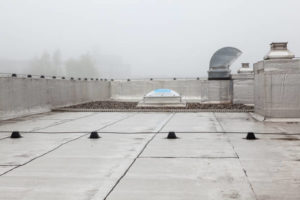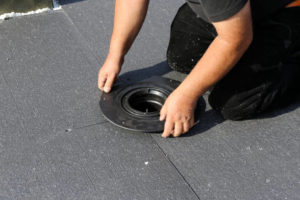Roof drainage systems are undoubtedly the unsung heroes of buildings. They play a vital role in maintaining the integrity of your home or commercial property but are often overlooked when it comes to proper maintenance and care. Roof drains move water from the surface of the roof and directs it into the gutters. This then prevents roof leaks that are notorious for damaging building interiors and the roofing system.
If your commercial or residential building does not feature a properly installed roof drainage system, then it’s like a ticking time bomb, and sooner or later, your building framework and structure will be compromised. This is especially true if the building is located in areas that are prone to wet and rainy seasons.

The Importance of Good Roof Drainage Systems
The main purpose of roof drains is to get rid of excess water from buildings. These systems are engineered to allow the free flow of rainwater, thereby preventing it from pooling on your building’s roof. Since most commercial buildings have flat or semi-flat roofs, they lack the natural run-off that’s present in pitch roofs. Without a roof drain, the standing water can cause severe damage to your roof. This is why the drainage stems are installed at the roof’s lowest point, as this is where most of the rainwater stagnates.
Roof drains also maintain the structural integrity of your building by eliminating the risk of interior damage due to water pooling. They are sometimes used as a conduit for melting snow, ultimately reducing the weight on your roof. Most importantly, they protect your roof from long-term and short-term damage, making it a cost-effective and low-maintenance investment.
As you research your options, keep in mind that different varieties of roof drain materials, including synthetics, metal, cast iron, plastics, so it’s crucial that you choose the one that’s most ideal for your building.
Consequences of Neglecting Roof Drainage Systems
To enhance the effectiveness of your roof drain systems, you should keep them properly maintained. Typically, the design of the gutters makes them vulnerable to debris accumulation. If left unmaintained, it could cause ice dams and result in water accumulation which is what you were avoiding in the first place.
Neglected roof drains can also weaken your building’s foundation and cause mildew growth and wet basements, triggering allergic reactions and causing respiratory diseases. The roof could sustain long-term damage that could be expensive to repair, and if it’s badly damaged, it could cave in or cause leakages inside the building.
One of the most underestimated effects of an unmaintained roof drain system is damaged landscaping. The water pooling around your home creates messy paths & walkways, and uneven surfaces.
Tips to Keep Your Roof Drain System Operating Optimally
To ensure your roof drain is operating as it should, make sure you;
- Inspect it at least twice annually and more if it’s susceptible to clogs.
- Regularly remove debris and objects that could damage or block the drainage system.
- Keep surrounding greenery trimmed to prevent the leaves and branches from clogging the system.
- Check the roof drain and gutters for leaks to ensure they’ll remain functional even in severe weather.
- Replace small gutters with larger ones that allow for an efficient flow of water.
- Use a drainage system that directs water away from your building to prevent it from pooling within its perimeter.
Make sure you also get rid of loose debris on the roof that could end up clogging the drain system.
Restoring roof drains on commercial and residential buildings is a complex process that should be left to the experts. For all kinds of drainage solutions, including relining old pipes, contact US Pipelining for professional help.
